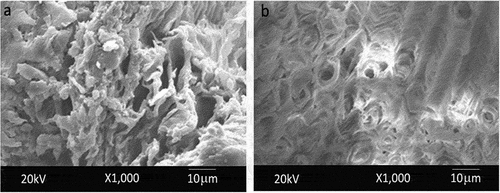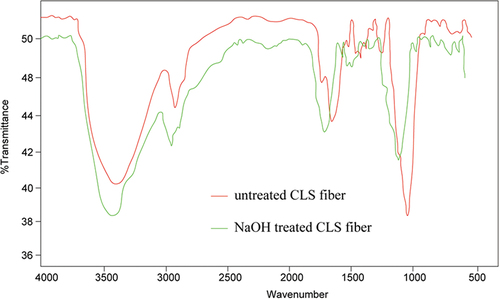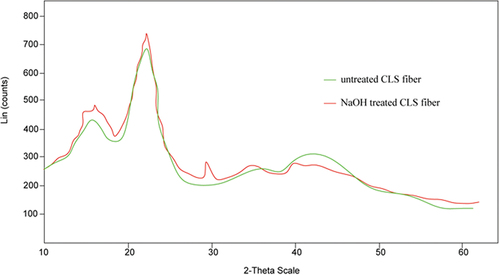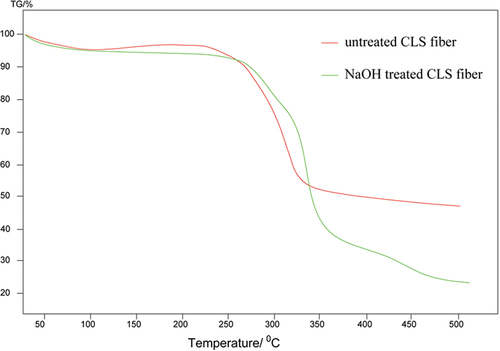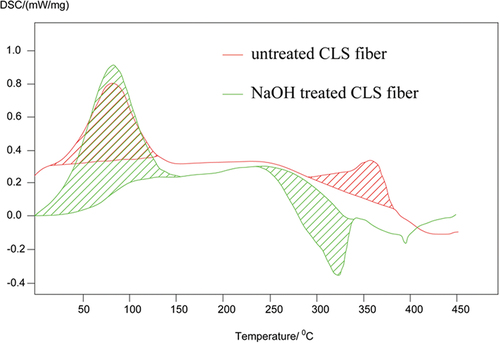ABSTRACT
The usage of new cellulosic fibers in industrial applications is massive because of its excellent performances. These fibers are utilized especially for manufacture of high-performance composites. Coconut leaf sheath (CLS) fibers are extracted for leaf sheath of coconut tree. The aim of this paper is to study the possibility of using a natural fiber CLS as an alternative for polymer composites. In the current study, the consequence of NaOH treatment on structural, thermal and morphological behavior of treated and untreated coconut leaf sheath (CLS) fiber in terms of single fiber tensile strength, Fourier transform infrared spectroscopy (FTIR), X-ray diffraction (×RD), thermogravimetric analysis (TGA) and differential scanning calorimeter (DSC) has been explored. From SEM analysis, it was identified globular lumps spread consistently over the fiber which could help the mechanical interlock with the resin. The outcomes from the experimentation exposed that the NaOH treatment has impacted in the eradication of amorphous hemicellulose and lignin contents from the CLS fiber surface and in turn resulted in excellent structural and thermal stability behaviour of fiber. The present work endorses the great potential of CLS fibers to be utilized for bio-reinforcement in order to fabricate lightweight composite structures, employed in automobile and structural applications.
摘要
新型纤维素纤维由于其优异的性能,在工业应用中得到了大量应用. 这些纤维特别用于制造高性能复合材料. 椰叶鞘(CLS)纤维是提取椰子树叶鞘的纤维. 本文的目的是研究使用天然纤维CLS作为聚合物复合材料替代品的可能性. 在当前的研究中,从单纤维拉伸强度、傅里叶变换红外光谱(FTIR)、X射线衍射(XRD)、热重分析(TGA)和差示扫描量热仪(DSC)等方面探讨了NaOH处理对处理和未处理椰叶鞘(CLS)纤维的结构、热和形态行为的影响. 通过SEM分析,发现纤维上均匀分布着球状团块,这有助于与树脂的机械联锁. 实验结果表明,NaOH处理影响了CLS纤维表面无定形半纤维素和木质素含量的消除,进而导致纤维具有良好的结构和热稳定性. 目前的工作表明,CLS纤维具有巨大的潜力,可用于生物增强,以制造用于汽车和结构应用的轻质复合结构.
Introduction
Natural fibers are used as reinforcing components in polymer composites because of their eco-friendly qualities. Natural fiber composites can be used in a variety of industrial goods due to the sophistication of advanced material development. In this regards, the use of cellulosic fibers is being enhanced by several researchers around the globe (Mansingh et al. Citation2021; Sajin et al. Citation2022). To meet the consumer needs and their expectations, a lot of scientific developments have been taken place that has increased the demand of utilization of natural fibers globally (Chandrasekar et al. Citation2017). In the field of biofiber, a remarkable revolution has been taken place in last few decades (Narayanasamy et al. Citation2020; Sanjay et al. Citation2019; Vinod et al. Citation2020). In developing countries, they give more significance for effective utilization of agricultural residues and value of these depends on the availability and usage (Bharath et al. Citation2020; Faruk et al. Citation2012). Cellulosic fibers from farming yield deposits, such as jute, sisal, coir, banana, pineapple leaf, and so on, are abundant, cheap, and readily available. Part of these vast quantities are maintained as animal feedstuff and for home use, while the majority are burnt in the field, causing environmental pollution (Madhu et al. Citation2018; Sanjay et al. Citation2018; Sarasini and Fiore Citation2018). Several researchers around the globe have successfully traded manmade fibers with locally available novel cellulosic fibers for the development of several commercial products (Binoj et al. Citation2020; Ramesh et al. Citation2020; Shravanabelagola Nagaraja Setty et al. Citation2021). These cellulosic fibers are non-scratchy to mingling and molding equipments and thus enable their cost effectiveness feature and positive ecological impact (Radoor et al. Citation2020; Senthamaraikannan et al. Citation2019; Singha and Thakur Citation2009). Composite manufacturing industries are now considering fibers such as jute, banana, flax, sisal, kenaf, and so on, as reinforcements to replace solid wood (Pineiro et al. Citation2020; Puttegowda et al. Citation2018; Sari et al. Citation2020). While evaluating the quality of rapeseed, both the chemical and morphological features of the seed were considered. The analysis envied that the proportions of cellulose and amorphous components detected in hardwood and typical non-wood products were comparable to those discovered in rapeseed stalks (Tofanica et al. Citation2011). The density of Rhectophyllum camerunense (RC) fiber was found to be very low. This shows RC fiber had extensive potential in mechanical applications (Beakou et al. Citation2008). (Fiore, Valenza, and Di Bella Citation2011) evaluated the mechanical properties of Artichoke (Cynara cardunculus L.) stem fibers through single fiber tensile test and also scrutinized the fibers using scanning electron microscopy, thermogravimetric and FTIR analysis (Fiore, Valenza, and Di Bella Citation2011). Brown coir fibers found in Hainan province (PR China) are investigated. Fiber fineness is analyzed and the weight of fiber with a length of around 35–225 mm will be credited for 88% of total fibers considered (Wang and Huang Citation2009). The thermo-mechanical behavior of hemp fibers has been considered in the manufacturing of good performance, natural fiber composites (Placet Citation2009). Bright et al. examined if coconut tree peduncle fiber (CTPF) may be used as a polymer composite reinforcement. The cellulose content (50.11 wt. %) gives CTPF strong single fiber tensile strength (137 MPa), and the porous surface promotes improved matrix adhesion. CTPF’s crystalline size and semi crystalline structure contributed to its low density (1.360 g/cm3) and water absorption. Lignin (24.9 wt. %), along with a low wax content (0.3 wt. %) and porous surfaces and micro fibrils, strengthens matrix-fiber bonds. Low density (1.360 g/cm3), semi-crystalline nature (52%), and greater crystalline size (6.5 nm) assure the least water absorption. DSC and thermo-gravimetric studies confirmed CTPF’s thermal stability above polymerization temperature (TGA) (Bright et al. Citation2021). The tensile test, morphology and thermogravimetric characterization of the curaua fiber was investigated. Among all other plant fibers used in natural fiber reinforced polymer composite, curaua fiber gives closest result in mechanical properties when compared with E- glass fiber (Silva and Aquino Citation2008). Biodegradable plant fiber extracted from fragrant screw pine (FSP) prop roots has been explored as a potential artificial fiber replacement in lightweight bio-based composite applications. Chemical, physical, FTIR, X-ray diffraction, SEM, DSC, and thermogravimetric tests were conducted to establish the suitability of FSP fiber as a new reinforcement. High cellulose (73.10 wt. %) and low wax concentration give good strength and bonding (0.35 wt. %) (Selvan et al. Citation2022). (Keskin et al. Citation2020) characterized fibers obtained from Centaurea solstitialis plant in terms of chemical composition, density and surface morphology behavior, crystallinity and thermal decomposition along with tensile properties. The results showed that the higher tensile strength and density impacted the utilization of Centaurea solstitialis fiber as a prospective reinforcement in green composite materials. Coconut palm or Coco’s nucifera belonging to a family of Arecaceae, grows abundantly in the coastal areas of all tropical countries and is nurtured around the ecosphere in about 100,000 km2. In this kind of plant family, the chemical constituents of fibers are cellulose (21−40%), lignin (15−47%), and hemicelluloses (12−27%) (Maheswari et al. Citation2012). Various fibers from different parts of coconut tree are utilized for different applications and CLS fibers left as waste residues are now being utilized as reinforcements in composites.
To the best of our information, no work has been reported on the evaluation of structural, thermal and morphological behavior of CLS fibers. In view of the above review and in order to find a suitable treatment for natural fibers, the present study investigates the consequence of NaOH treatment on CLS fibers. In addition, the study examines the influence of NaOH treatment on this fiber’s structural, thermal, and morphological properties in order to confirm its potential for usage as reinforcement in composite structures.
Materials
A coconut leaf sheath with fibers is shown . In the present investigation, CLS procured from the trees were thoroughly washed with tap water and then desiccated in sunlight for 7 days. The CLS which was cleaned is parted to inner sheath mat from the exterior layer fibers. From inner sheath mat, fibers are extracted and were treated with 5% aqueous NaOH (sodium hydroxide) solution for a day at room temperature. Both treated as well as untreated fibers were utilized for further experimentations.
Experimentation
Single fiber tensile test
Single fiber tensile test (SFTT) for NaOH-treated and untreated fiber sample were carried out to know various tensile properties using INSTRON universal testing machine, UK. A crosshead speed of 5 mm/min and a gauge length of 50 mm was maintained throughout the test (Raj et al. Citation2021). Five trials in each case were tested and average values were documented. The morphological behavior of both treated and untreated fibers were scrutinized using JEOL JSM 820 scanning electron microscope (SEM).
Fourier Transform Infrared Spectroscopy (FTIR)
Perkin Elmer 16 PC FTIR equipment (USA) at a resolution of 4 cm−1 and 32 scans per each case was utilized in carrying out a qualitative identification of various constituents in untreated and treated CLS fibers. The analysis was recorded in a typical function group ranging from 4000–500 cm−1 regions.
X-ray Diffraction (XRD)
Rigaku Dmax 2500 diffractometer (Japan) with a reflection mode and scan speed ranging 2°/min was used in performing X-ray diffraction spectra analysis. The untreated and treated CLS fibers were scanned at 2θ range varying from 5° to 60°. Using XRD, crystallinity index and increased in the amorphous content of the fiber can be determined.
Thermogravimetric Analysis (TGA)
The thermal stability behavior of both treated and untreated CLS fibers in powder form were analyzed using Perkin – Elmer TGA-7 equipment (USA). The thermal degradation in terms of global weight loss was studied at a temperature range maintained between 250° and 500°C.
Differential Scanning Calorimetry (DSC)
DSC measurements were carried out by boiling NaOH-treated and untreated CLS fiber samples. The DSC was performed to know the melting and glass transition temperature of the fibers and was conducted at an inert atmosphere ranging from 0° to 450°C.
Results and discussion
Single fiber tensile test
displays average tensile strength, young’s modulus and percentage of elongation results of both untreated and NaOH-treated CLS fibers. It was observed that, owing to fiber treatment, 30–50% upsurge in tensile strength of the fibers as opposed to untreated fibers was clearly noticeable. This improvement is mainly attributed due to chemical treatment which would enhance crystallinity nature of fibers by eliminating amorphous materials like hemicellulose, lignin, wax and other fatty substances from the fiber surface (Izani et al. Citation2013; Sawpan, Pickering, and Fernyhough Citation2011). The tensile strength of modified fibers dissolute of soft materials which origins a drop in spiral angle of cellulose microfibril which will allow for reordering of cellulose chains and increases cellulose chain packing order (Pineiro et al. Citation2020).
Table 1. Tensile properties of untreated and NaOH-treated CLS fibers.
The treated fibers when compared to other treatments showed good enhancement of strength and elongation at break of fibers (Madhu et al. Citation2020; Saha et al. Citation2010). SEM micrographs of untreated and treated CLS fibers were utilized to investigate their consequence on fiber morphology as revealed in the , respectively. There are filths like waxes and oil on surface of untreated fibers (). After treatment, the surface is cleaned by removing the impurities, which, in turn, reduce the fiber diameter ().
Due to the treatment, the cellulose microfibrils gets well ranged in solitary direction. This acts on middle lamella and on the primary cell wall by dissolving pectins and removing hemicellulose. The hydrophilic behavior of cellulose present on the surface increases the adhesion force (Le Troëdec et al. Citation2011). In the treated fibers, the elimination of surface impurities and inorganic particles results in rough surface. These remarks show that strength augmentation relates to defibrillation. It is observed that micro pores and elimination of artificial layer which can upsurge the contact area in treated fibers as shown in . It is also justified that, the amputation of filths on the surface is more beneficial for fiber and matrix bond as it provides better mechanical interlocking and good bonding reaction (Izani et al. Citation2013).
FTIR analysis
illustrates the FT-IR spectrum peaks of untreated and the treated CLS fibers respectively. From and , it can be seen that group of peaks at around 1734 cm−1 and 1833 cm−1 of untreated and treated CLS fibers respectively corresponds to the hemicellulose content. The absorption peaks at 3420 cm−1 and 2920 cm−1 are ascribed to α-cellulose while the other bands of peaks are ascribed to lignin content. Further, for treated fibers the intensity of the bands analogous to percentage of α-cellulose increases and the hemicellulose decreases (Wang and Huang Citation2009). The peak at 1850 cm−1 symbolizes the CO bonds and emphasizes that upon NaOH treatment, the amorphous hemicellulose content is eradicated from the fiber surfaces which in turn would correspond to good set of chemical composition values (Jayaramudu, Guduri, and Rajulu Citation2010; Sgriccia, Hawley, and Misra Citation2008). The FTIR studies confirm on alkali treatment that, the hemicellulose content decreases noticeably which can be observed clearly owing to the desertion of these characteristic stretching vibrations (Reddy et al. Citation2013).
Table 2. Peak positions and allocations of chemical groups in untreated and NaOH-treated CLS fibers.
XRD analysis
The X-ray diffractogram of the untreated and NaOH-treated CLS fibers are presented in . The crystallinity index (CI) is determined by using the below equation (Reddy et al. Citation2013).
Where I002 represent maximum crystalline peak intensity and Iam indicate the intensity of amorphous peaks.
is evident that the intensity of the crystalline peaks of NaOH-treated fibers is superior to that of the untreated fibers. From , the CI of NaOH-treated fibers is found to be prominent than the untreated fibers and this can be credited due the absence of amorphous hemicellulose content from the treated fibers. The treated fiber displays more crystalline character due to the rearrangement of the crystalline regions (Madhu et al. Citation2020). From of untreated and of alkali treated CLS fibers, we can observe from the peaks that cellulose content had increased drastically after the alkali treatment of fibers (D’Almeida, Aquino, and Monteiro Citation2006).
Table 3. Peak positions and CI values of untreated and NaOH-treated CLS fibers.
TGA
The TG curves of the untreated and NaOH-treated CLS fibers are presented in . The decomposition profiles of the untreated fibers are characterized in three stages. The first stage of decomposition occurred at a shoulder peak around 243°C and corresponded to hemicellulose degradation. The peak at 288°C matches to thermal deprivation of cellulose, while the last stage at around 371°C corresponded to oxidative dilapidation of lignin. The first stage of degradation in untreated (240−290°C) and treated (255−300°C) CLS fibers is related to thermal depolymerization of hemicellulose, pectin and the cleavage of glycosidic linkages of cellulose. While the second stage occurring in the untreated (320−350°C) and treated (320−360°C) CLS fibers is ascribed to the deprivation of α-cellulose present in the fiber, that is, weight loss of 61% in untreated and weight loss of 53% in treated CLS fibers.
Finally, residual mass left in untreated fiber is 19% at 498°C and in treated CLS fibers is about 47% at 504°C. Generally, because of the multifarious structure of lignin, the decomposition happens gradually within the entire temperature range (De Rosa et al. Citation2010). The considerable outcome of the thermal degradation behavior is observed in treated fibers (Roy et al. Citation2012). The thermal stability of NaOH-treated fibers is greater than that of untreated fiber and this is due to decrease in amorphous hemicellulose content of the fiber (Rajulu, Devi, and Venunadhan Citation2006). The treated fibers offer excellent resistance to thermal deprivation by eliminating natural and artificial impurities and thus improving the rougher surfaces in them (Aisyah et al. Citation2009; Alawar, Hamed, and Al-Kaabi Citation2009; Ayu et al. Citation2020). Besides, the treatment potentially also offers the advantages of being good biodegradable solution (Jumaidin et al. Citation2020; Nurazzi et al. Citation2020).
DSC analysis
shows DSC results of untreated and NaOH-treated CLS fibers to determine the thermal behavior of fiber. An extensive endothermic peak observed around the temperature ranges 10−140°C in both untreated as well as in the treated fibers ascribes to vaporization and the same has been illustrated in .
Table 4. DSC data of untreated and NaOH-treated CLS fibers.
The lignin content degrades at a temperature around 200−250°C. From the , it is evident the absence of endothermic/exothermic peaks at the temperature ranges 150°C and 240°C envies the steadiness of the treated CLS fibers at these temperature zones.
The initial exothermic hump in the DSC curve for untreated fibers is about 290°C which signifies the thermal degradation of hemicellulose. For the NaOH-treated CLS fibers, the eradication of hemicellulose have resulted in the lowering of exothermic hump representing the decomposition of hemicellulose (Sinha and Rout Citation2009). From the DSC curve, it is seen that the cellulose was more defiant and was displayed through an endothermic peak, while the hemicellulose content was exhibited by an exothermic peak for the untreated CLS fibers. For the NaOH-treated fibers, the cellulose decomposition peak became exothermic perhaps due of the rupture of chemical linkages between the constituents because of the elimination of hemicellulose (Alawar, Hamed, and Al-Kaabi Citation2009).
Conclusions
The influence of NaOH treatment on structure, morphology and thermal properties of CLS fibers were investigated. It was found that the removal of non-cellulosic substances by NaOH treatment is the core rationale for the improvement of fiber tensile properties. The fiber becomes less thick and rough, because of the elimination of nebulous substances on the fiber surface which were detected by using the SEM micrographs. The FTIR proved that the abolition of amorphous hemicellulose from the fibers is caused by the NaOH treatment. The XRD measurements indicate a remarkable augment in crystallinity of modified fibers which is due to loss of amorphous hemicellulose. An enhancement in thermal stability and diminish in the moisture content on the fiber was due to the augment in crystallinity as shown in TGA. In DSC, the results obtained after NaOH treatment illustrated an enhancement in surface area through D – condition which was due to weather desorption. The obtained curves brace the postulation that moisture plays a prime role in fiber behavior during the glass transition region. Hence, the current work provides a novel loom for successful utilization of CLS fibers. The renewable and environment friendly CLS fibers can be an apt reinforcing material that can be used in composite structures for biocomposites, textile and packaging applications.
Data availability
The raw/processed data required to reproduce these findings cannot be shared at this time as the data also forms part of an ongoing study.
Supplemental Material
Download MS Word (14.6 KB)Disclosure statement
No potential conflict of interest was reported by the author(s).
Supplemental data
Supplemental data for this article can be accessed online at https://doi.org/10.1080/15440478.2022.2134257.
Additional information
Funding
References
- Aisyah, H. A., M. T. Paridah, S. M. Sapuan, A. Khalina, O. B. Berkalp, S. H. Lee, C. H. Lee, N. M. Nurazzi, N. Ramli, M. S. Wahab, et al. 2009. Thermal properties of woven kenaf/carbon fibre-reinforced epoxy hybrid composite panels. International Journal of Polymer Science 5258621:1–11. doi:10.1155/2019/5258621.
- Alawar, A., A. M. Hamed, and K. Al-Kaabi. 2009. Characterization of treated date palm tree fiber as composite reinforcement. Composites Part B: Engineering 40 (7):601–06. doi:10.1016/j.compositesb.2009.04.018.
- Ayu, R. S., A. Khalina, A. S. Harmaen, K. Zaman, T. Isma, Q. Liu, R. A. Ilyas, et al. 2020. Characterization study of empty fruit bunch (EFB) fibers reinforcement in poly (Butylene) succinate (PBS)/starch/glycerol composite sheet. Polymers 12 (7):1571. doi:10.3390/polym12071571.
- Beakou, A., R. Ntenga, J. Lepetit, J. A. Ateba, and L. O. Ayina. 2008. Physico-chemical and microstructural characterization of “Rhectophyllum camerunense” plant fiber. Composites Part A, Applied Science and Manufacturing 39 (1):67–74. doi:10.1016/j.compositesa.2007.09.002.
- Bharath, K. N., P. Madhu, T. Y. Gowda, M. R. Sanjay, V. Kushvaha, and S. Siengchin. 2020. Alkaline effect on characterization of discarded waste of Moringa oleifera fiber as a potential eco-friendly reinforcement for biocomposites. Journal of Polymers and the Environment 28 (11):2823–36. doi:10.1007/s10924-020-01818-4.
- Binoj, J. S., R. E. Raj, S. A. Hassan, M. Mariatti, S. Siengchin, and M. R. Sanjay. 2020. Characterization of discarded fruit waste as substitute for harmful synthetic fiber-reinforced polymer composites. Journal of Materials Science 55 (20):8513–25. doi:10.1007/s10853-020-04620-8.
- Bright, B. M., B. J. Selvi, S. Abu Hassan, M. M. Jaafar, S. Suchart, M. R. Sanjay, and K. N. Bharath. 2021. Characterization of natural cellulosic fiber from cocos nucifera peduncle for sustainable biocomposites. Journal of Natural Fibers 1–11. doi:10.1080/15440478.2021.1982827.
- Chandrasekar, M., M. R. Ishak, S. M. Sapuan, Z. Leman, and M. Jawaid. 2017. A review on the characterisation of natural fibres and their composites after alkali treatment and water absorption. Plastics, Rubber and Composites 46(3):119–36. doi:10.1080/14658011.2017.1298550.d.
- D’Almeida, J. R. M., R. C. M. P. Aquino, and S. N. Monteiro. 2006. Tensile mechanical properties, morphological aspects and chemical characterization of piassava (Attalea funifera) fibers. Composites Part A, Applied Science and Manufacturing 37 ((9)):1473–79. doi:10.1016/j.compositesa.2005.03.035.
- De Rosa, I. M., J. M. Kenny, D. Puglia, C. Santulli, and F. Sarasini. 2010. Morphological, thermal and mechanical characterization of okra (Abelmoschus esculentus) fibres as potential reinforcement in polymer composites. Composites Science and Technology 70 (1):116–22. doi:10.1016/j.compscitech.2009.09.013.
- Faruk, O., A. K. Bledzki, H. P. Fink, and M. Sain. 2012. Biocomposites reinforced with natural fibers: 2000–2010. Progress in Polymer Science 37 (11):1552–96. doi:10.1016/j.progpolymsci.2012.04.003.
- Fiore, V., A. Valenza, and G. Di Bella. 2011. Artichoke (Cynara cardunculus L.) fibres as potential reinforcement of composite structures. Composites Science and Technology 71 (8):1138–44. doi:10.1016/j.compscitech.2011.04.003.
- Izani, M. N., M. T. Paridah, U. M. K. Anwar, M. M. Nor, and P. S. H’Ng. 2013. Effects of fiber treatment on morphology, tensile and thermogravimetric analysis of oil palm empty fruit bunches fibers. Composites Part B: Engineering 45 (1):1251–57. doi:10.1016/j.compositesb.2012.07.027.
- Jayaramudu, J., B. R. Guduri, and A. V. Rajulu. 2010. Characterization of new natural cellulosic fabric Grewia tilifolia. Carbohydrate Polymers 79 (4):847–51. doi:10.1016/j.carbpol.2009.10.046.
- Jumaidin, R., M. A. Khiruddin, Z. A. Saidi, M. S. Salit, and R. A. Ilyas. 2020. Effect of cogon grass fibre on the thermal, mechanical and biodegradation properties of thermoplastic cassava starch biocomposite. International Journal of Biological Macromolecules 146:746–55. doi:10.1016/j.ijbiomac.2019.11.011.
- Keskin, O. Y., R. Dalmis, G. B. Kilic, Y. Seki, and S. Koktas. 2020. Extraction and characterization of cellulosic fiber from Centaurea solstitialis for composites. Cellulose 27 (17):9963–74. doi:10.1007/s10570-020-03498-8.
- Le Troëdec, M., A. Rachini, C. Peyratout, S. Rossignol, E. Max, O. Kaftan, A. Fery, and A. Smith. 2011. Influence of chemical treatments on adhesion properties of hemp fibres. Journal of Colloid and Interface Science 356 (1):303–10. doi:10.1016/j.jcis.2010.12.066.
- Madhu, P., M. R. Sanjay, A. Khan, A. A. Otaibi, S. A. Al-Zahrani, S. Pradeep, S. Siengchin, P. Boonyasopon, and S. Siengchin. 2020.Hybrid effect of PJFs/E-glass/carbon fabric reinforced hybrid epoxy composites for structural applications. Journal of Natural Fibers 19: 1–11.doi: 10.1080/15440478.2020.1848724
- Madhu, P., M. R. Sanjay, P. Senthamaraikannan, S. Pradeep, S. S. Saravanakumar, and B. Yogesha. 2018. A review on synthesis and characterization of commercially available natural fibers: Part-I. Journal of Natural Fibers 16:1132–44. doi:10.1080/15440478.2018.1453433.
- Maheswari, C. U., K. O. Reddy, E. Muzenda, B. R. Guduri, and A. V. Rajulu. 2012. Extraction and characterization of cellulose microfibrils from agricultural residue-Cocos nucifera L. Biomass. Bioenergy 46:555–63. doi:10.1016/j.biombioe.2012.06.039.
- Mansingh, B. B., J. S. Binoj, N. P. Sai, S. A. Hassan, S. Siengchin, M. R. Sanjay, and Y. C. Liu. 2021. Sustainable development in utilization of Tamarindus indica L. and its by-products in industries: A review. Current Research in Green and Sustainable Chemistry 4:100207. doi:10.1016/j.crgsc.2021.100207.
- Narayanasamy, P., P. Balasundar, S. Senthil, M. R. Sanjay, S. Siengchin, A. Khan, and A. M. Asiri. 2020. Characterization of a novel natural cellulosic fiber from Calotropis gigantea fruit bunch for ecofriendly polymer composites. International Journal of Biological Macromolecules 150:793–801. doi:10.1016/j.ijbiomac.2020.02.134.
- Nurazzi, N. M., A. Khalina, S. M. Sapuan, R. A. Ilyas, S. A. Rafiqah, and Z. M. Hanafee. 2020. Thermal properties of treated sugar palm yarn/glass fiber reinforced unsaturated polyester hybrid composites. Journal of Materials Research and Technology 9 (2):1606–18. doi:10.1016/j.jmrt.2019.11.086.
- Pineiro, V., J. Arias, J. Dürr, P. Elverdin, A. M. Ibáñez, A. Kinengyere, M. Torero, N. Owoo, J. R. Page, S. D. Prager, et al. 2020. A scoping review on incentives for adoption of sustainable agricultural practices and their outcomes. Nature Sustainability 3 (10):809–20. doi:10.1038/s41893-020-00617-y.
- Placet, V. 2009. Characterization of the thermo-mechanical behaviour of Hemp fibres intended for the manufacturing of high-performance composites. Composites Part A, Applied Science and Manufacturing 40 (8):1111–18. doi:10.1016/j.compositesa.2009.04.031.
- Puttegowda, M., S. M. Rangappa, M. Jawaid, P. Shivanna, Y. Basavegowda, and N. Saba. 2018. Potential of natural/synthetic hybrid composites for aerospace applications. In Sustainable Composites for Aerospace Applications, ed. M. Jawaid and M. Thariq, 315–51. Sawston: United Kingdom. doi:10.1016/B978-0-08-102131-6.00021-9.
- Radoor, S., J. Karayil, S. M. Rangappa, S. Siengchin, and J. Parameswaranpillai. 2020. A review on the extraction of pineapple, sisal and abaca fibers and their use as reinforcement in polymer matrix. eXPRESS Polymer Letters 14 (4):309–35. doi:10.3144/expresspolymlett.2020.27.
- Raj, S. S., A. M. Kuzmin, K. Subramanian, S. Sathiamoorthyi, and K. T. Kandasamy. 2021. Philosophy of selecting ASTM standards for mechanical characterization of polymers and polymer composites. Materiale Plastice 58 (3):247–56. doi:10.37358/MP.21.3.5523.
- Rajulu, A. V., R. R. Devi, and A. Venunadhan. 2006. Thermo gravimetric analysis of ridge gourd natural fabric reinforcement. Journal of Reinforced Plastics and Composites 25 (8):815–19. doi:10.1177/0731684406065064.
- Ramesh, M., C. Deepa, L. R. Kumar, M. R. Sanjay, and S. Siengchin. 2020. Life-cycle and environmental impact assessments on processing of plant fibres and its bio-composites: A critical review. Journal of Industrial Textiles 21:1528083720924730. doi:10.1177/1528083720924730.
- Reddy, K. O., C. U. Maheswari, M. Shukla, J. I. Song, and A. V. Rajulu. 2013. Tensile and structural characterization of alkali treated borassus fruit fine fibers. Composites Part B: Engineering 44 (1):433–38. doi:10.1016/j.compositesb.2012.04.075.
- Roy, A., S. Chakraborty, S. P. Kundu, R. K. Basak, S. B. Majumder, and B. Adhikari. 2012. Improvement in mechanical properties of jute fibres through mild alkali treatment as demonstrated by utilisation of the Weibull distribution model. Bioresource Technology 107:222–28. doi:10.1016/j.biortech.2011.11.073.
- Saha, P., S. Manna, S. R. Chowdhury, R. Sen, D. Roy, and B. Adhikari. 2010. Enhancement of tensile strength of lignocellulosic jute fibers by alkali-steam treatment. Bioresource Technology 101 (9):3182–87. doi:10.1016/j.biortech.2009.12.010.
- Sajin, J. B., R. C. Paul, J. S. Binoj, B. B. Mansingh, M. G. A. Selvan, K. L. Goh, M. S. Saravanan, and M. S. Senthil Saravanan. 2022. Impact of fiber length on mechanical, morphological and thermal analysis of chemical treated jute fiber polymer composites for sustainable applications. Current Research in Green and Sustainable Chemistry 5:100241. doi:10.1016/j.crgsc.2021.100241.
- Sanjay, M. R., P. Madhu, J. Mohammad, S. Pradeep, P. Senthamaraikannan, and S. Senthil. 2018. Characterization and properties of natural fiber polymer composites: A comprehensive review. Journal of Cleaner Production 172:566–81. doi:10.1016/j.jclepro.2017.10.101.
- Sanjay, M. R., S. Siengchin, J. Parameswaranpillai, M. Jawaid, C. I. Pruncu, and A. Khan. 2019. A comprehensive review of techniques for natural fibers as reinforcement in composites: Preparation, processing and characterization. Carbohydrate Polymers 207:108–21. doi:10.1016/j.carbpol.2018.11.083.
- Sarasini, F., and V. Fiore. 2018. A systematic literature review on less common natural fibres and their biocomposites. Journal of Cleaner Production 195:240–67. doi:10.1016/j.jclepro.2018.05.197.
- Sari, N. H., C. I. Pruncu, S. M. Sapuan, R. A. Ilyas, A. D. Catur, S. Suteja, Y. A. Sutaryono, and G. Pullen. 2020. The effect of water immersion and fibre content on properties of corn husk fibres reinforced thermoset polyester composite. Polymer Testing 91:106751. doi:10.1016/j.polymertesting.2020.106751.
- Sawpan, M. A., K. L. Pickering, and A. Fernyhough. 2011. Effect of various chemical treatments on the fibre structure and tensile properties of industrial hemp fibres. Composites Part A, Applied Science and Manufacturing 42 (8):888–95. doi:10.1016/j.compositesa.2011.03.008.
- Selvan, M. T. G. A., J. S. Binoj, J. T. E. J. Moses, N. P. Sai, S. Siengchin, M. R. Sanjay, and Y. Liu. 2022. Extraction and characterization of natural cellulosic fiber from fragrant screw pine prop roots as potential reinforcement for polymer composites. Polymer Composites 43 (1):320–29. doi:10.1002/pc.26376.
- Senthamaraikannan, P., S. S. Saravanakumar, M. R. Sanjay, M. Jawaid, and S. Siengchin. 2019. Physico-chemical and thermal properties of untreated and treated Acacia planifrons bark fibers for composite reinforcement. Materials Letters 240:221–24. doi:10.1016/j.matlet.2019.01.024.
- Sgriccia, N., M. C. Hawley, and M. Misra. 2008. Characterization of natural fiber surfaces and natural fiber composites. Composites Part A, Applied Science and Manufacturing 39 (10):1632–37. doi:10.1016/j.compositesa.2008.07.007.
- Shravanabelagola Nagaraja Setty, V. K., G. Govardhan, S. Mavinkere Rangappa, and S. Siengchin. 2021. Raw and chemically treated bio‐waste filled (Limonia acidissima shell powder) vinyl ester composites: Physical, mechanical, moisture absorption properties, and microstructure analysis. Journal of Vinyl and Additive Technology 27 (1):97–107. doi:10.1002/vnl.21787.
- Silva, R. V., and E. M. F. Aquino. 2008. Curaua fiber: A new alternative to polymeric composites. Journal of Reinforced Plastics and Composites 27 (1):103–12. doi:10.1177/0731684407079496.
- Singha, A. S., and V. K. Thakur. 2009. Morphological, thermal, and physicochemical characterization of surface modified Pinus fibers. International Journal of Polymer Analysis and Characterizationn 14 (3):271–89. doi:10.1080/10236660802666160.
- Sinha, E., and S. K. Rout. 2009. Influence of fibre-surface treatment on structural, thermal and mechanical properties of jute fibre and its composite. Bulletin of Materials Science 32 (1):65–76. doi:10.1007/s12034-009-0010-3.
- Tofanica, B. M., E. Cappelletto, D. Gavrilescu, and K. Mueller. 2011. Properties of rapeseed (Brassica napus) stalks fibers. Journal of Natural Fibers 8 (4):241–62. doi:10.1080/15440478.2011.626189.
- Vinod, A., M. R. Sanjay, S. Suchart, and P. Jyotishkumar. 2020. Renewable and sustainable biobased materials: An assessment on biofibers, biofilms, biopolymers and biocomposites. Journal of Cleaner Production 258:120978. doi:10.1016/j.jclepro.2020.120978.
- Wang, W., and G. Huang. 2009. Characterisation and utilization of natural coconut fibres composites. Materials & Design 30 (7):2741–44. doi:10.1016/j.matdes.2008.11.002.


